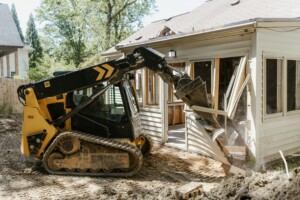
This case study, Feng Shui and Remodel Additions, was made for modern living. With hardly any ancient Feng Shui texts on how to interpret a house that has been remodeled, current-day practitioners like myself have been left to discover and document what happens to a house when it has additions.
I do recall reading about how a house’s shape will change, with a redistribution of the directional grid, when an room is built to accommodate the eldest son when he brings his wife to live with his birth family. It was a very Old World reference, where a small room is added onto a square shaped house. “Nothing to write home about.”
However, we know in modern times that people remodel and expand frequently and one does not need to be royalty in order to afford the luxury of adding on to the home. With modern building technologies, we also see people take risks with all kinds of avant-garde architecture.
This case study lists quite a few different types of additions and what happens with the flying star chart, such as : when you add up, add out, add underneath an existing house and the various reasons for why an original Period chart will stay intact or get overtaken by a new Period chart.
Many other considerations are discussed, such as a new addition having a different orientation from the original house.
EXCERPT:
“The average door is 2 ½ to 3 feet wide. In different countries the dimensions will be slightly different, but we can refer to an ordinary doorway as one which allows a single person to pass through easily. It is a “mouth” or “Qi gate.” It allows the Qi to move into another room as the Qi travels up and down walls. The flying stars may do the same, another type of Qi. But the flying stars are a distinct type of Qi which also rides on a directional path regardless of walls put up or not.
We could say that a dying tree has sha Qi: Negative energy. But the tree is not hosting a flying star in the same way that a built structure hosts flying stars, all subject to timeliness and untimeliness according to the Xuan Kong Fei Xing doctrines. So, here we can tease out the subtle differences between Qi which can course through a house like a draft of wind, in contrast to a grid of energy that stays mostly in place, confined by the exterior walls of a structure.
With this ordinary door opening from the original house, to a single room addition, the door may or may not be big enough to allow the original Qi to seep into the newly constructed space. Much of the time we can consider a single room addition to be an extension of the flying star directional zone that it is attached to. In other words, if a room is added to an existing room with a 6-x-2 flying star combination, then the 6-x-2 flying stars will travel into the new space via the new doorway opening.
If we have, however, a room which is built up against a house with access to the new room only from the outside, then of course we can give the newer construction its own separate flying star chart. And it could easily have a different orientation as well.
You can take the approach of handling a single room addition as just an extension of the original house chart. You could also micro-manage the singular new room for its own later Period construction cycle and see if anything about the room’s influence rings true. There may be an overlapping of influences.”
Chock full of renovation examples, this case study also highlights additions with different floor levels or ceiling heights from the original house, adding on a second story with or without removing the ceiling from the first floor, how to interpret missing directional sector areas, connecting a detached garage to a house, and how to relate to an enclosed patio or Sun Room.
Author: Kartar Diamond
Company: Feng Shui Solutions (R)
From the Architecture and Design Blog Series
Share This Story, Choose Your Platform!
Go to Top

